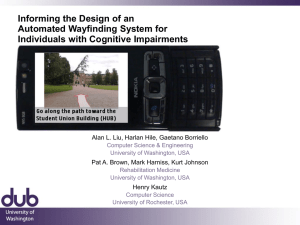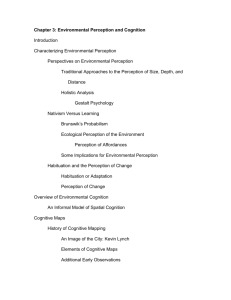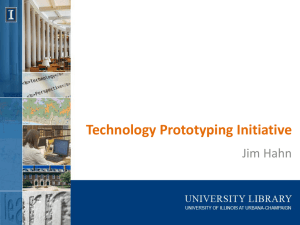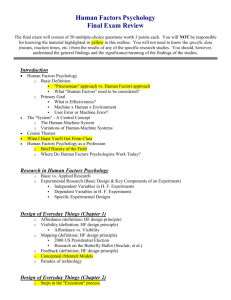Evaluating a Wayfinding System for Individuals with Cognitive Impairment Abstract
advertisement
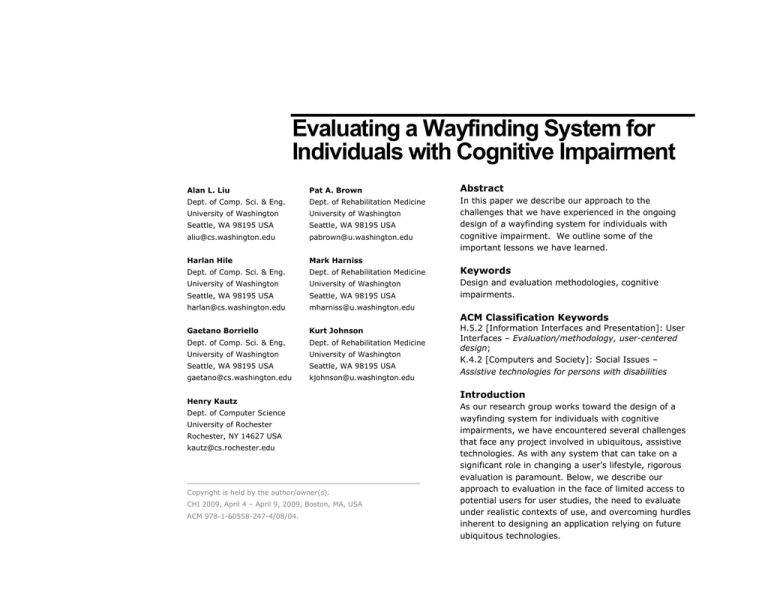
Evaluating a Wayfinding System for Individuals with Cognitive Impairment Alan L. Liu Pat A. Brown Abstract Dept. of Comp. Sci. & Eng. Dept. of Rehabilitation Medicine University of Washington University of Washington Seattle, WA 98195 USA Seattle, WA 98195 USA aliu@cs.washington.edu pabrown@u.washington.edu In this paper we describe our approach to the challenges that we have experienced in the ongoing design of a wayfinding system for individuals with cognitive impairment. We outline some of the important lessons we have learned. Harlan Hile Mark Harniss Dept. of Comp. Sci. & Eng. Dept. of Rehabilitation Medicine Keywords University of Washington University of Washington Seattle, WA 98195 USA Seattle, WA 98195 USA Design and evaluation methodologies, cognitive impairments. harlan@cs.washington.edu mharniss@u.washington.edu Gaetano Borriello Kurt Johnson Dept. of Comp. Sci. & Eng. Dept. of Rehabilitation Medicine University of Washington University of Washington Seattle, WA 98195 USA Seattle, WA 98195 USA gaetano@cs.washington.edu kjohnson@u.washington.edu Henry Kautz Dept. of Computer Science University of Rochester Rochester, NY 14627 USA kautz@cs.rochester.edu Copyright is held by the author/owner(s). CHI 2009, April 4 – April 9, 2009, Boston, MA, USA ACM 978-1-60558-247-4/08/04. ACM Classification Keywords H.5.2 [Information Interfaces and Presentation]: User Interfaces – Evaluation/methodology, user-centered design; K.4.2 [Computers and Society]: Social Issues – Assistive technologies for persons with disabilities Introduction As our research group works toward the design of a wayfinding system for individuals with cognitive impairments, we have encountered several challenges that face any project involved in ubiquitous, assistive technologies. As with any system that can take on a significant role in changing a user’s lifestyle, rigorous evaluation is paramount. Below, we describe our approach to evaluation in the face of limited access to potential users for user studies, the need to evaluate under realistic contexts of use, and overcoming hurdles inherent to designing an application relying on future ubiquitous technologies. 2 Limited access to study participants One of the biggest challenges we face is considering how to deal with the smaller population of potential study participants. Each individual's unique combination of abilities and disabilities creates a “universe-of-one” situation [3] that makes evaluation difficult. As Moffatt et al. note [5], traditional evaluation derives generalizable results by removing individual differences among study participants in controlled experiments, but when designing for special populations, those differences are one of the central issues to consider. Figure 1. Left: Example direction displayed on a HP iPAQ. Right: Visual directions consisted of photos, symbols, photos with overlaid arrows, and photos with highlight regions. Figure 2. Example set of directions given to participants at one fixed location. Besides success in following a given direction, we also noted occurrences of hesitation, confusion, misinterpretation, distraction, and other behaviors. Our research approach has been to involve potential users, caregivers, and job coaches in a participatory design process to learn their needs and issues in wayfinding[1]. In our iterative design process, we have conducted three separate user studies. We did not intend for the studies to simply expose design flaws, but also to uncover major factors that affect the usability of directions common across multiple users, as well as important differences such as functional abilities and expectations relating to following directions. Participants were recruited through existing client relationships between individuals and our medical center, as well as through support group email lists. We first designed and evaluated a handheld prototype in an indoor study (n=7)[4]. The goals of the first study were to find out whether our potential users could follow directions from the system at all, and whether individuals had different preferences for types of directions and their presentation. Thus, we simulated the functionality of the system using the Wizard-of-Oz technique. Each participant was tasked with following directions given via a handheld device (see Figure 1) to navigate three routes of differing complexity through 3 an unfamiliar building. Directions for each route were given in different modalities, determined with a partial Latin squares design to reduce ordering effects. Participant feedback was noted both during the tasks and after each via a set of questions. While the number of participants in all our studies have been limited by small population sizes and our own resources, by purposely recruiting a diverse set of participants in our first study, we were able to get a variety of perspectives on our design. Given the exploratory and preliminary state of our research, we focused on qualitative results, such as participant comments, and discussed study observations as a group to reach an agreement on interpretations when participant comments were terse or ambiguous. Evaluation under realistic conditions While controlled studies afford easier analysis, evaluation in its intended context of use, under realistic conditions, is critical. Our first study was set in a relatively sterile indoor environment with few distractions, but potential users will also need wayfind in a chaotic outdoor environment where traffic, pedestrians, noises, etc. are all expected. However, it is difficult to analyze a study where every participant has a unique set of tasks set in a unique environment. Therefore, we set our second study in an outdoor campus environment to examine how wayfinding might change in the presence of more distractions, but had each participant navigate the same set of routes (n=6). The study included a baseline condition so that we could observe how participants wayfind without the system. Participants were again assigned routes using a partial Latin square design to avoid ordering effects, but the baseline condition was always the first route in order to not bias participants toward the system. Some participants had also participated in our first study, but as there was more than a year in between studies, none of them reported remembering details of the system. In contrast to our previous studies, the goal of our third study (n=9) was to determine what commonalities among our user population could guide the choice of landmark and direction to use. We isolated the task of following a landmark direction and had participants follow five different directions at each of four locations, randomly ordered. Directions were varied by landmark type, orientation with respect to the user, alignment with respect to the path, and canonical or perspective photos of the landmark affected navigation accuracy (see Figure 2). This format allowed us to gather significantly more data points than our previous studies for the quantitative analysis that we believed to be appropriate that the stage of the design. Designing for Tomorrow Our three studies have shaped our design by illuminating many of the factors that influence wayfinding success for individuals with cognitive impairments. However, evaluating our system involves far more work to produce generalizable, ecologically valid results. To evaluate our system with real tasks, we intend to include individuals who are learning a new route with their caregiver or job coach in our future studies. Ideally, we would also have a fully automated system for such evaluation. Wizard-of-Oz simulation of system sensing and logic was appropriate to get early feedback on initial designs 4 but future studies must have more automation in order to glean feedback that cannot be derived when the system is operating with idealized, but unrealistic, accuracy or judgment. Our design assumes the future availability of accurate sensing, wide-scale connectivity, and geographically-indexed information such as photos and building floorplans. Such availability may be inevitable, but it may also depend on compelling applications to create demand. In order to create a functional prototype, we have also been working on a system to more easily create and extract geo-tagged images of landmarks [2]. studies involving potential users, caregivers, and job coaches, we have been able to understand what those differences are and how they impact usability. For ecological validity, we intend to evaluate our system in more realistic conditions. To do so involves some “bootstrapping,” such as populating landmark information that we believe will be widely available in the near future. Our last hurdle, and that of any application for special populations, is the rigid hardware platform and developmental environment that are intended for general purpose development and thus have limitations that prevent current devices from being readily deployable. Mobile hardware limitations Our final challenge involves the limited mobile hardware options available to researchers. Choices for screen size, button placement, and the ability to override default behaviors are limited to available phone model options. During our studies there were occurrences of device behavior beyond the control of particular development environments, ranging from permanently-enabled power-saving modes blanking the screen to participants’ accidental keypresses that forced our application to quit. Perhaps a touchscreen device might alleviate some of the keypress problems, but still leaves other issues that phone manufacturers and carriers have not considered important, and thus omitted from current development environments. Conclusion Challenges that we have faced in evaluating the design of a wayfinding system for individuals with cognitive impairment include limited study participation, dealing with differences due to our target population’s individual abilities and disabilities, and technological hurdles. By conducting early-stage design and user References [1] Brown, P., Harniss, M., and Johnson, K. Cognitive support technologies: implications for design and user interface. In Proc. Tech and Persons with Disabilities 2006. 2006. [2] Hile, H. Vedantham, R., Liu, A., Gelfand, N., Cuellar, G., Grzeszczuk, R., and Borriello, G. LandmarkBased Pedestrian Navigation from Collections of Geotagged Photos. In Proc. MUM 2008, ACM Press (2008). [3] Kintsch, A. and dePaula, R. A framework for the adoption of assistive technology. SWAAAC 2002, Assistive Technology Partners (2002). [4] Liu, A.L., Hile, H., Kautz, H., Borriello., G., Brown, P.A., Harniss, M., and Johnson, K. Indoor wayfinding: developing a functional interface for individuals with cognitive impairments. In Proc. ASSETS 2006, ACM Press (2006), 95-102. [5] Moffatt, K., Findlater, L., and Allen, M. Generalizability in research with cognitively impaired individuals. CHI 2006 Workshop Designing Technology for People with Cognitive Impairments. 2006.

